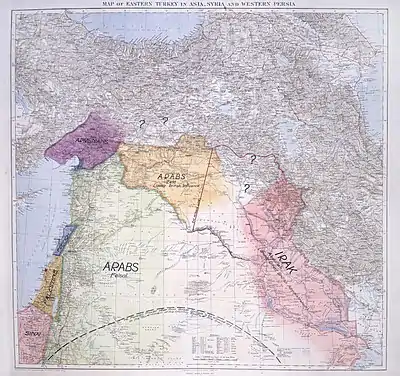Zeid bin Hussein
Zaid bin Hussein, GCVO, GBE (Arabic: زيد بن الحسين; February 28, 1898 – October 18, 1970) was an Iraqi prince who was a member of the Hashemite dynasty and the head of the Royal House of Iraq from 1958 until his death, after the royal line founded by his brother Faisal I of Iraq died out.
| Zaid bin Hussein | |
|---|---|
 | |
| Head of the royal houses of Iraq and Syria | |
| Tenure | 14 July 1958 – 18 October 1970 |
| Predecessor | Faisal II |
| Successor | Ra'ad bin Zeid |
| Born | 28 February 1898 Ottoman Empire |
| Died | 18 October 1970 (aged 72) Paris, France |
| Spouse | Fahrelnissa Zeid |
| Issue | Prince Ra'ad bin Zeid |
| House | Hashemite |
| Father | Hussein bin Ali |
| Mother | Adila Khanum |

Biography
Prince Zaid was the fourth son of Hussein bin Ali, who was the Sharif and Emir of Mecca, and only son of Hussein and his third wife, Adila Khanum. He was educated at Galatasaray High School in Stamboul (Istanbul), Constantinople College and Balliol College, Oxford.
From 1916 to 1919, Prince Zeid was the Commander of the Arab Northern Army. In 1918, T. E. Lawrence suggested that he be made king of a truncated north-western Syria.[1] The advent of French rule resulted in his assignment in 1923 to the Iraqi Cavalry and he was promoted to Colonel.
Zeid was also Iraqi ambassador in Berlin and in Ankara in the 1930s and in London in the 1950s.
On July 14, 1958, Prince Zeid became Head of the Royal House of Iraq, following the assassination of his grand-nephew King Faisal II by General Muhammad Najib ar-Ruba'i, who proclaimed Iraq to be a republic. Zeid and his family continued to live in London, where the family resided during the coup, as Zeid was the Iraqi ambassador there.
Prince Zeid died in Paris on October 18, 1970, and was buried in the Royal Mausoleum at Raghdan Palace, Amman, Jordan. His son prince Ra'ad bin Zeid succeeded him as head of the Royal House of Iraq.
Marriage and children
In November 1933, Zeid married Princess Fahrelnissa Zeid in Athens, Greece. Together they had one son:
- Prince Ra'ad bin Zeid - born February 18, 1936, married to Margaretha Inga Elisabeth Lind.
Ancestry
References
- "Lawrence's Mid-East map, as displayed at Imperial War Museum, London". BBC News. 2005-10-11. Archived from the original on 2021-05-06. Retrieved 2017-11-24.
- Kamal Salibi (15 December 1998). The Modern History of Jordan. I.B.Tauris. ISBN 9781860643316. Retrieved 7 February 2018.
- "Family tree". alhussein.gov. 1 January 2014. Retrieved 8 February 2018.
.svg.png.webp)